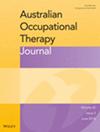Implementation of occupation-centred practice by occupational therapists in acute adult physical settings: A mixed method study in a regional and rural health service
Abstract
Introduction
Occupational therapy is underpinned by the belief that occupation facilitates health and wellbeing. However, evidence suggests that occupational therapists encounter challenges to implementing occupation-centred practice. The aim of this study was to investigate the uptake, acceptability and impact of a workplace intervention designed to enhance occupation-centred practice of occupational therapists in an acute adult physical context.
Methods
A concurrent mixed methods study using a pre–post design was employed. The setting was a regional and rural health service in Queensland. Data were collected using an online survey of occupational therapists' knowledge, attitude and confidence regarding occupational therapy models, an audit of medical charts and focus group discussion and in-depth interviews. Quantitative data were presented using descriptive statistics, and discussions were thematically analysed.
Consumer and Community Involvement
No involvement.
Results
Survey results revealed minimal difference between pre- (n = 8) and post- (n = 8) interventions. The medical chart audit (pre = 40, post = 28) revealed an increase in occupational language over medically based language. Four themes were identified from the qualitative data (pre = 5, post = 6): change in theoretical awareness and acceptance of occupational therapy models; facilitators for adoption of occupational therapy models in the acute setting; what it takes: the qualities and efforts required of individuals; and enhanced professional identity. The themes revealed that participants varied in their knowledge and implementation of occupation-centred practice pre-intervention and could feel constrained by the workplace context. Post-participants recognised that actively practising occupation centredness impacted positively on their practice.
Conclusion
Participation in an initiative to increase occupation-centred practice resulted in changed behaviours and beliefs for occupational therapists in this study. Participants recognised that their individual contribution and the concerted efforts of their occupational therapy peers led to increased professional identity and understanding of occupational therapy contribution in the acute adult physical setting.
PLAIN LANGUAGE SUMMARY
Occupational therapists promote health and wellbeing by working with people of all abilities to participate in the everyday occupations of life. However, within some hospital settings, occupational therapists face a number of challenges to implementing their desired approach due to time restrictions and dominance of other professions. Because of this, consumers and health colleagues in hospitals are unclear on the role or value of occupational therapists, and occupational therapists feel misunderstood. This may impact on job satisfaction, retention of staff in this setting and missed opportunities for identifying needs for consumers. In a regional and rural setting, this may be further complicated by occupational therapists working in isolation from direct professional support.
In this project, occupational therapists in a regional and rural health service participated in an activity aimed to enhance their communication and confidence in their unique approach. The activity involved developing and using tools and resources for a hospital context that were ‘occupation-centred’ or were based on ‘occupational therapy models’. Despite occupational therapists reporting that making this change required effort, they recognised that with persistence and collaboration, there was an improved understanding of occupational therapy contribution in the setting and better job satisfaction for occupational therapists. The tools and resources that were developed can be easily adopted by other organisations. These findings show that occupational therapists working in hospitals can alter their behaviours and beliefs to be more true to the profession. And that this benefits occupational therapists, consumers and the broader health-care team.

 求助内容:
求助内容: 应助结果提醒方式:
应助结果提醒方式:


